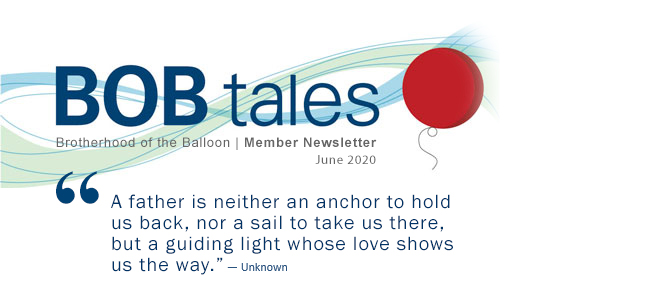
Dear Members (a note from Deb Hickey):
Have you ever thought about who might play you in a movie? If you read our last issue of BOB Tales, you remember my father Bob Marckini complaining about his overgrown hairdo as a result of barber shops and hair salons being closed down. He mentioned growing a beard for the second time in his life. The first time was 15 years ago when he thought the result would be a George Clooney look-a-like, but he ended up more Willie Nelson.
That’s not the first time my father has likened himself to George Clooney. I can recall several times he’s (jokingly?) suggested that Clooney would be the best choice to play him in a movie.
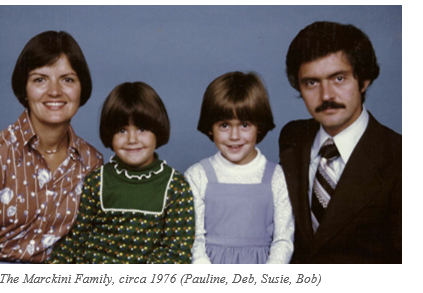 In celebration of Father’s Day next month, I’d like to return to the mid-70s for a moment. Have you heard the phrase, “The mustache makes the man”? I think this Marckini family photo is a perfect interpretation of that slogan. But I don’t see Clooney on the far right – I see the late Kurt Vonnegut. Gene Shalit, perhaps. Cheech or Chong?
In celebration of Father’s Day next month, I’d like to return to the mid-70s for a moment. Have you heard the phrase, “The mustache makes the man”? I think this Marckini family photo is a perfect interpretation of that slogan. But I don’t see Clooney on the far right – I see the late Kurt Vonnegut. Gene Shalit, perhaps. Cheech or Chong?
Today, with his overgrown locks, Bob Marckini is channeling Albert Einstein. I’ll spare you the photo.
All humor aside, I’d like to continue with a letter to my father for Father’s Day …
Dear Dad,
As I’m struggling to balance work with my domestic duties while I’ve become a homeschool teacher overnight, I’ve realized that time is the one thing I wish I had more of and the one thing that seemingly disappears faster and faster the harder I work and the older I get. Sometimes, I stop to look at the clock on the wall to watch it tick, somehow expecting that if I stare at the hands, they’ll move more slowly.
Often when I do take a moment to stop – stop running around; stop jumping from one task to another; stop stressing about the cleanliness of my house; stop trying to complete every assignment the teacher doles out while urging my child to go for the bonus question when her eyes are filled with tears and my head is in my hands – I’m able to refocus and go back.
I return to the time in my life when the simple sound of the garage door opening as you came home from work gave me such comfort. I’m able to go back to the cold winter nights when you’d come in after Mom tucked me in and I knew you were going to tell me a story – not the one you read in a book, but the kind you make up. I remember when you played that old organ with the dual keyboard in this lively kind of way with a goofy smile on your face. “The Entertainer” was my favorite. I remember how I rode around on your feet, which were so big to me, my pudgy cheek smacked against your leg. You pretended you couldn’t find me and that you had no idea you had a kid on your foot. Sweaty hugs. Those were the best. You’d come home from a jog wearing your gray track suit, soaked through with perspiration. “I need a hug!” You’d shout joyfully as you looked around, eventually affixing your eyes on me. A chase pursued. I can’t remember who “won,” but I remember the excitement I felt as we ran around the house. You chose blue for the Christmas lights in our windows when seemingly every other house had white. On those rare occasions when I see blue lights these days, I get a lump in my throat – the kind you get when you’d do anything to go back in time … just once.
Where’d the time go? The thought of how fast it has flown by is a powerful and sobering revelation.
As I look in the mirror at the lines on my face, I can’t believe 47 years have gone by.
I know I can’t stop time. The one thing I can do is take a moment every day and thank God you’re still here – and tell you how much that means to me – tell you how thankful I am that you’re a part of my every day. What a treasure that is.
Father’s Day is June 21. Happy Father’s Day to the hundreds of dads in our group. And to my dad, Bob Marckini: Thank you for acting like a kid when I was a kid. Thank you for being a friend when I needed a friend. And Dad, thank you for being a parent when I needed one (and still do). You are the best man I know. Happy Father’s Day.
As always, we have a comprehensive issue this month. We’re still covering the biggest topic in the media – COVID-19 – and also how it relates to cancer. You’ll learn why cancer doesn’t care about the virus that’s overtaken the world and how prostate cancer patients can manage their disease during the pandemic. We report on a proton therapy center that’s initiating the largest antibodies study of its kind; new research that compares the hydrogel spacer to the rectal balloon; the importance (again) of a second opinion; why smokers are at higher risk for coronavirus; why physical activity is more important for prostate cancer patients than previously thought; and much more.
But first, we have some updates on the COMPPARE clinical trial. As you may recall from previous BOB Tales, this study, led by the dynamic Dr. Nancy Mendenhall, medical director from the University of Florida Health Proton Therapy Institute, will compare proton therapy to IMRT for treating prostate cancer. It’s a large (3,000 total participants), prospective, controlled study comparing patient results including disease-free survival as well as quality of life issues and side effects. There will also be analysis of a variety of treatment-related issues, including a comparison by race (black vs. white), age (65 and under vs. over 65), and prostate cancer aggressiveness for all endpoints.
Learn more about the COMPPARE trial.
This month, Dr. Mendenhall announced they’re expanding the eligibility criteria for participants of the trial as a result of feedback from principal investigators at the 2020 COMPPARE Workshop that Bob and I attended back in January.
The following five changes have been implemented:
- The maximum age of participants has been increased from 80 to 85.
- Life Expectancy Estimation (LEE) has decreased from ≥ 10 year to ≥ 8 year.
- Very low-risk patients are included in the trial.
- Patients with prior Benign Prostatic Hyperplasia (BPH) procedures, such as TURP and GreenLight Laser, are included.
- Irritable Bowel Syndrome (IBS) is only an exclusion if a patient is undergoing active treatment or is symptomatic.
If you’re interested in participating or know someone who is considering proton therapy or IMRT for prostate cancer treatment and may be interested in the COMPPARE study, please visit the Participant Information page, email [email protected], or contact me for more information.
We hope you enjoy this month’s BOB Tales and, as always, we welcome and anticipate your valuable feedback. Please send an email to [email protected].
Deb Hickey
To print the BOB Tales newsletter or view the newsletter with a larger font size, click here for the PDF file.
In This Issue:
- The Virus That’s Trumping Cancer … for Now
- Managing Prostate Cancer During the COVID-19 Pandemic
- Hospital Offers Blood Antibody Testing to All Employees, Patients
- Hydrogel Spacer Lowers Rectal Bleeding vs. Rectal Balloon
- Once Again – The Importance of a Second Opinion
- Prostate Cancer and Diet Pattern Linked
- Smokers at Higher Risk for COVID-19
- Prostate Cancer: Physical Activity More Important than Previously Thought
- Omega 3 and Prostate Cancer
- Hand Washing Wins Every Time
- Whole Foods Organics Come from China?
- Can Your Dog Get Prostate Cancer?


The Virus That’s Trumping Cancer … for Now
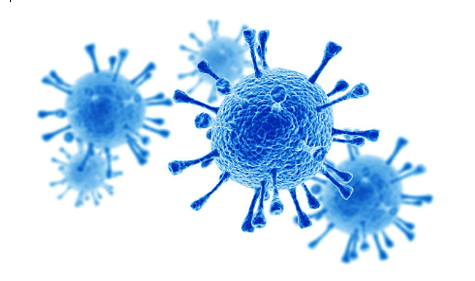 It takes a lot to overshadow the second-leading cause of death globally, but with the rapid rate of transmission coupled with limited data, a shortage of tests and equipment, no proven treatment or vaccine, the novel coronavirus has become the biggest worldwide health threat in modern history.
It takes a lot to overshadow the second-leading cause of death globally, but with the rapid rate of transmission coupled with limited data, a shortage of tests and equipment, no proven treatment or vaccine, the novel coronavirus has become the biggest worldwide health threat in modern history.
But while scientists, researchers, and other health professionals are working furiously to crack COVID-19, oncologists are reinventing the way they care for patients by rescheduling appointments and noncritical procedures; setting up telehealth visits, and rewriting policy to ensure the safety of their patients and staff.
At the same time, cancer patients are navigating obstacles they never imagined they’d face. After receiving a devastating cancer diagnosis, they must consider whether to move forward with treatment and risk exposure to a deadly virus, or delay treatment, potentially causing adverse outcomes. Older patients and those with comorbidities face even greater challenges because they may be more susceptible to COVID-19 infection.
A medical oncologist compared treating cancer during this pandemic to charting a course between the monsters Scylla and Charydbis.
Cancer Doesn’t Care About Coronavirus
An oncologist in the United Kingdom recently stated, “60,000 cancer patients could die because of lack of treatment or diagnosis.” Though coronavirus may have stolen the spotlight for the time being, cancer doesn’t peak and it’s never going away. But while COVID-19 is spreading like wildfire, some cancer patients’ decision to delaying treatment could have a negative impact on future prognosis. Some people are avoiding doctor’s offices and hospitals at all costs which means there may be thousands of people who have cancer but won’t know it until it’s too late to treat effectively. For most cancers, early diagnosis is crucial; health organizations worldwide have urged people to get screened early and consistently, yet that’s been quickly undone by COVID-19.
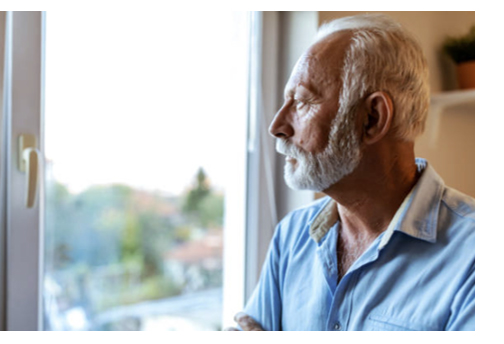 The UK’s National Health Service (NHS) has reported that diagnostic equipment is being unused and oncologists have few new patients to see. Some worry about the backlog of patients that have yet to be diagnosed and the effect it will have on hospitals when things return to normal. Will there be room and resources to help these people?
The UK’s National Health Service (NHS) has reported that diagnostic equipment is being unused and oncologists have few new patients to see. Some worry about the backlog of patients that have yet to be diagnosed and the effect it will have on hospitals when things return to normal. Will there be room and resources to help these people?
Coronavirus has affected every part of the world and therefore every single one of us. Our collaborative effort to battle this virus by staying home and practicing social distancing has been remarkable, but in the process, have we thrown down our weapons in the fight against cancer?
Managing Prostate Cancer During the COVID-19 Pandemic
Cancer treatment during the COVID-19 pandemic requires consideration of the risks and benefits for patients and caregivers. Prostate cancer is a heterogenous disease where timely treatment is necessary for some, while active surveillance, or deferral of treatment, could be acceptable for others.
In an effort to help cancer patients and their physicians in their decision to move forward with or delay treatment, an international team of radiation oncologists developed the “RADS” framework. RADS stands for “Remote visits, and Avoidance, Deferment, and Shortening of radiotherapy.”
The consensus is that all aspects of patient care including visits, treatment, and resource utilization should be reduced during this time, but not to the detriment of the patient. Researchers also recommend protecting patients and care providers through increased use of telemedicine.
“The complexity of treatment of prostate cancer has increased with more frequent use of advanced imaging, including MRI and molecular PET imaging, image guidance with fiducial markers, and rectal spacers, most of which require extra procedures or visits, and some that require extra use of PPE,” wrote the researchers. “Thus, prostate cancer patients represent an important population that radiation oncology departments need to efficiently manage in times when resources are limited.”
The RADS recommendations are listed below:
- Remote visits should be used in place of in-person visits when patients don’t need to be seen physically to determine a course of treatment. The added value of a physical exam is usually outweighed by the risk of COVID-19 exposure.
- Avoid radiation when evidence suggests it would be of little or no benefit to a patient. Multiple clinical trials have shown favorable outcomes with a watchful approach to monitoring patients with low- to intermediate-risk cancers.
- Delay treatment for as long as possible, depending on each patient’s individual circumstances. If a patient’s disease is progressing rapidly, the benefits of treatment must be weighed against COVID-19 exposure and other potential risk factors, such as other chronic conditions the patient may already have.
- Shorten radiotherapy treatments to the shortest number that have been shown to be safe and effective. This can help limit the number of visits each patient will need to make.
To create the RADS framework, the researchers analyzed national guidelines and systematic reviews, along with data from clinical trials. The authors explained that they created this framework for prostate cancer because it’s a unique disease compared to other forms of cancer. Most prognoses aren’t aggressive, but for those that are, hormone therapy can delay the start of treatment for several months.
Note: The RADS guidelines apply only to patients who haven’t tested positive for COVID-19. Those who have tested positive should follow instructions from their caretakers and health officials.
Note: Information and research on the COVID-19 pandemic is constantly changing. For the latest information and updates, visit the CDC’s website.
Hospital Offers Blood Antibody Testing to All Employees, Patients
The National Association for Proton Therapy (NAPT) holds a meeting every Friday to discuss the impact of the COVID-19 pandemic on proton therapy research and treatment centers; key strategies for infection control among patients and staff; and how to move forward with cancer care. Deb Hickey, along with representatives from most of the U.S. proton centers and others in the proton world, faithfully attend these events.
At a recent meeting, a physician from the Beaumont Proton Therapy Center in Royal Oak, MI spoke about the largest antibodies study of its kind being done at his facility. Researchers at Beaumont aim to determine how many people among their 38,000 employees and thousands of affiliates have COVID-19 antibodies and never reported symptoms.
They’ll ask a series of questions with a goal of learning how susceptible health care workers are to acquiring COVID-19; what the relationship is between antibody levels to symptoms or the severity of disease; if the antibody response increases or decreases over time and how long it lasts; and if COVID-19 antibodies protect people from new cornavirus infections.
The Beaumont testing capability will be available to other area hospital systems after initial results come in. The study will run for five years.
Hydrogel Spacer Lowers Rectal Bleeding vs. Rectal Balloon
Following two years of research in men undergoing proton therapy for localized prostate cancer, findings showed treatment with the rectal hydrogel spacer, SpaceOAR, better protects the rectum from radiation than the rectal balloon immobilization. Specifically, the use of SpaceOAR significantly reduced the risk of late rectal bleeding and was also associated with better bowel quality of life as reported by patients.
The study included data from 267 patients treated for localized prostate cancer undergoing standard fractionated proton therapy from 2013 to 2018. A total of 192 men were treated with the rectal balloon, and 75 men received the hydrogel spacer.
“Treatments often do not perform as well in clinical practice as they do in clinical trials, and yet we found that the rectal-sparing benefit of the hydrogel spacer, particularly for reducing late rectal bleeding, was even greater than expected. These findings can hold interest for urologists who counsel patients about their treatment options for localized prostate cancer,” said co-author William J. Ellis, MD.
Once Again – The Importance of a Second Opinion
This is happening so often it’s frightening. Even though we’re not medical professionals and can’t offer medical advice, we always encourage men who contact us to get a second opinion on their biopsy results. As we’ve reported in the past, fully a third of the time, when a second opinion from a preeminent pathology lab is solicited, the results are changed, mostly to the lower side. In two cases – as reported in Bob’s new book – the second opinion reported no cancer present. That’s zero-cancer-present (confirmed by follow-up biopsies). In both cases, the men were scheduled for treatment, one had a radical prostatectomy planned for the following month. Needless to say, treatment was canceled.
Last month another gentleman who lives in Bob’s community called and shared his cancer staging information, which included a Gleason score of 4+3 in one core. Hormonal therapy was prescribed followed by either surgery or external beam radiation.
Bob gave him a copy of his new book, encouraged him to read it and suggested a second opinion on his biopsy slides. The gentleman had consults planned at two prominent Boston hospitals, so, he asked both to render opinions on his slides. Both hospitals changed the 4+3 to 3+4.
This is significant, because it changed his options from an aggressive treatment protocol involving hormonal therapy to one of either active surveillance or a basic protocol for early-stage prostate cancer.
This patient has opted for basic, hypofractionated proton therapy, an option that wouldn’t have been offered had he stayed with the initial biopsy reading.
The lesson learned: It never hurts to get a second opinion on biopsy results.

We have been producing BOB Tales newsletters monthly for almost 20 years. During this time there have been articles that many new members have not seen, and some older members may have forgotten. So, we periodically re-run some articles from past newsletters. This one from November 2005 is titled:
Prostate Cancer and Diet Pattern Linked
A diet high in refined grain products, processed meats, red meat and organ meat seems to increase the risk of developing prostate cancer, a Canadian study shows. Dr. Kristan J. Aronson, of Queen's University in Kingston, Ontario, and colleagues looked into the dietary patterns of 80 men with prostate cancer and 334 cancer-free men being seen at urology clinics. The participants completed questionnaires about food prior to diagnosis and intake was assessed for the two years prior to enrolling in the study. As described in the International Journal of Cancer, the researchers identified four dietary patterns: Healthy Living, Traditional Western, Processed Diet, and Beverages. The Processed Diet, which was composed of processed meats, red meats, organ meats, refined grains, onions and tomatoes, vegetable oils and juices, soft drinks, and bottled water, was associated with a more than doubled risk of prostate cancer.
The Traditional Western pattern was rich in red meats, processed meats, organ meats, eggs, milk, dessert, potatoes, mayonnaise, nuts, cream for coffee, tap water, and liquor. This pattern was associated with a slightly increased prostate cancer risk. The Healthy Living pattern was heavy on vegetables, fruits, whole grains, fish and poultry. The Beverage diet pattern contained tap water, soft drinks and fruit juices, potatoes, poultry and margarine, and the absence of alcohol.
Neither of these last two patterns was associated with increased prostate cancer risk. “These results support the idea that consumption of fruits, vegetables and poultry may be associated with decreased prostate cancer risk and consumption of meat, refined grains and possibly soft drinks is associated with increased prostate cancer risk,” Dr. Aronson and colleagues conclude. SOURCE: International Journal of Cancer, September 2005, reported in Reuters Health, NY.


You Can Beat Prostate Cancer: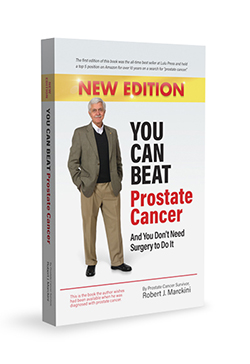
And You Don’t Need Surgery to Do It – Second Edition
At the beginning of the second edition of Bob’s book, you’ll find several endorsements from prominent medical and business leaders. The following is from Dr. Steven J. Frank, MD, FACR, Professor and Executive Director, The University of Texas MD Anderson Cancer Center Proton Therapy Center:
For men diagnosed with prostate cancer, Bob Marckini in this book clarifies from a patient’s perspective why proton therapy is an ideal treatment option over surgery in order to preserve erections, eliminate incontinence, and prevent penile shortening … A must read for prostate cancer patients and their families.
Early Success
The success of the new book continues to exceed our expectations. As of this writing, it’s in the No. 2 position on a “prostate cancer” search on Amazon where there are more than 4,000 books on the subject. The book is being discovered by newly diagnosed men, and they’re letting us know how valuable it’s been to them, particularly in helping them understand their diagnosis and the pros and cons of virtually every treatment option.
Positive Reader Feedback
The feedback we’ve received so far has been truly awesome (in the real sense of the word). One reader sent us the following email:
Your book is terrific! You did a great job in transitioning from the original. This book should be on any prostate cancer victim’s must-read list before doing anything! It is current, and in my opinion objective with supporting data. Still, you can lead a horse to water... Too many will default to the knife and potential unnecessary misery. But for those with some intellect and some drive, your book will be most helpful.
I don’t know how much feedback you get on “readability.” The book just flows; it is quick, easy to read, interesting, and fun. You have a real knack for this, blending in human interest experiences.
Reminders
The second edition of You Can Beat Prostate Cancer includes a complete update on prostate cancer prevention, imaging technology, diagnostic technology, treatment options, and virtually all aspects of the latest developments in proton therapy.
Proton centers are beginning to acquire the new book and send it to patients making inquiries about proton therapy. We have no doubt this will educate patients on the benefits of proton therapy and help them with their treatment decisions.
We are happy to discount books in quantity (minimum 20) to anyone who is interested spreading the word on proton therapy. Just send an email to [email protected]. Proceeds from book sales are used to help fund our efforts and to support proton therapy research.
Please note: The Kindle version is free to Kindle Unlimited members or can be purchased for only $9.99, for non-members. The soft-cover price is $22.45

Buy You Can Beat Prostate Cancer second edition on Amazon or Lulu Press.


Smokers at Higher Risk for COVID-19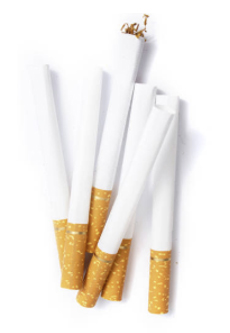
Researchers from Loma Linda University (LLU) conducted two studies in Southeast Asia showing that smokers are at greater risk of contracting and spreading infectious disease. An estimated 34 million adults in the U.S. who smoke may also be at greater risk of complications from COVID-19.
Researchers from LLU’s Transdisciplinary Tobacco Research Program reported findings from National Institutes of Health (NIH)-funded studies that showed the use of tobacco increases a person’s susceptibility and transmission of infectious disease due to the sharing of smoking materials and because smoking impairs mucociliary function in the lungs.
Principal investigator Pramil Singh, DrPH says these findings can be instrumental in understanding how smoking can affect both the spread of and complications from COVID-19.
Prostate Cancer: Physical Activity More Important than Previously Thought
One of the largest studies ever to use genetics as a measurement for physical activity’s effect on prostate cancer revealed that physical activity reduces the risk of prostate cancer by more than half. And as we’ve mentioned before, “exercise” doesn’t have to mean hitting up the gym or running every day; it can simply mean taking a walk or gardening.
Over 140,000 men were included in the study, of which, 80,000 had prostate cancer. Researchers found that people with the variation in their DNA sequence that makes them more likely to be active, had a 51 percent reduced risk of prostate cancer than people who didn’t have this variation.
Dr. Sarah Lewis, Senior Lecturer in Genetic Epidemiology at Bristol Medical School: Population Health Sciences, and senior author, said, “This study is the largest-ever of its kind that uses a relatively new method that complements current observational research to discover what causes prostate cancer. It suggests that there could be a larger effect of physical activity on prostate cancer than previously thought, so will hopefully encourage men to be more active.”
Omega 3 and Prostate Cancer
We have many members who take omega 3 supplements, believing it helps prevent a recurrence of prostate cancer. However new research shows that while omega 3 supplements may slightly reduce the risk of heart disease, they may actually increase the risk of prostate cancer, though marginally.
Researchers used data from more than 100,000 participants to study the risks and benefits associated with the food supplement.
“This large amount of information has clarified that if we take omega 3 supplements for several years we may very slightly reduce our risk of heart disease, but balance this with very slightly increasing our risk of some cancers,” said lead author Dr. Lee Hooper. “We found that there is no demonstrable value in people taking omega 3 oil supplements for the prevention or treatment of cancer.”
Hand Washing Wins Every Time
A reader of Marilyn vos Savant’s syndicated column in Parade Magazine (April 19, 2020) asked the question: Why do bacteria and viruses survive various over-the-counter products that claim to destroy them? This was her answer:
A vast variety of bacteria exists, but nearly all are harmless, beneficial, or necessary. Viruses are just the opposite. So, the point is not what percentage is killed, but rather which ones. Some species are simply unaffected by these products. In fact, studies indicate that outside of health care settings, the use of ordinary soap and water – that is, mechanically rinsing off the germs – works just as well and is likely to be even better at preventing disease.
Whole Foods Organics Come from China?
Whole Foods is the leading food retailer selling the image that local and organic foods are better for the environment and better for you. But is that what customers are getting?
The health food store has been under scrutiny for years about the questionable quality of their produce, and the issue is getting highlighted again – most likely due to the burst in organic produce sales due to the coronavirus outbreak.
Whole Foods is the undisputed leader in organic foods, known for their 365 brand, and they actively promote locally grown products. But did you know much of their 365 products come from China?
Organic food is free of fertilizers, pesticides; growth hormones, and livestock feed additives. Products in the U.S. must pass strict USDA standards before they can be marked as organic. But how do we know food marked as “organic” from China – or any other country, for that matter – is free of these chemicals?
It’s challenging for consumers to trace the source of the products they’re buying. A good rule of thumb is to buy local when possible. If you can’t buy local, read labels. And you may also want to avoid the following 21 “dangerous” foods from China:
|
|

NAPT Virtual National Proton Conference
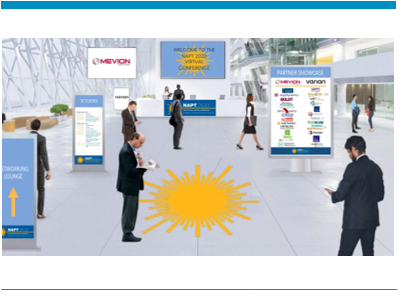 The eighth annual National Proton Conference, which was scheduled for April 26-29, 2020 in Nashville, TN, was canceled due to the coronavirus outbreak. After evaluating options, the team at the National Association for Proton Therapy (NAPT) has decided to provide a robust, one-day virtual conference on Friday, July 24, 2020.
The eighth annual National Proton Conference, which was scheduled for April 26-29, 2020 in Nashville, TN, was canceled due to the coronavirus outbreak. After evaluating options, the team at the National Association for Proton Therapy (NAPT) has decided to provide a robust, one-day virtual conference on Friday, July 24, 2020.
“The proton therapy community has united in the past few months in a way never experienced in our history,” said NAPT Executive Director, Jennifer Maggiore. “The COVID-19 outbreak has created an opportunity for us to strengthen our collaborative efforts and support each other. Our annual conference has always been an eagerly anticipated event for our members, technology and business partners, and others interested in the advancement of proton therapy. During challenging times, it’s more important than ever to stay connected and share information.”
NAPT has partnered with Extraordinary Events and will deliver a full-engagement solution offering attendees, sponsors, and exhibitors the ability to easily connect with each other; network with colleagues in virtual chat rooms; and view presentations at their convenience.
For more information or to register, contact Jane Fort at [email protected].

Conversations with Donors
Every month, we receive a list of members who’ve made contributions to the Robert Marckini Chair for Proton Therapy Research or Loma Linda University Health’s Vision 2020 campaign, though we don’t know the exact amounts given. And every month, we spend a lot of time reaching out to each person on these lists to thank them. The reason is two-fold: 1) We’re truly appreciative of the gift and we believe each one makes a difference. And, 2) we use the contact as an excuse to check in with our members to see how they’re doing – some 1-, some 10-, some 20+ years out of treatment. Often, the things our members – or their significant others – say really warm our hearts or make us laugh. Below are a few of our favorite quotes from last month.
I still feel guilty about my proton treatment. So many people suffer from prostate cancer and there I was golfing and having a great time. - BOB Member, Brentwood, CA
The BOB Tales is my favorite read. I enjoy it more than the newspaper. – BOB Member, Sarasota, FL
I’m cancer-free and feeling better than ever. How can I not give back? I’ll do whatever I can for as long as I can! – BOB Member, Smyrna, GA
I always look forward to the BOB Tales. I read it aloud to [my husband] and we discuss; it includes a tremendous amount of wonderful information. Thank you for your efforts and commitment to keeping us healthy and informed! - BOB Member Spouse, Steilacoom, WA
I really appreciate the gifts I’ve been given. - BOB Member, Santa Barbara, CA
Loma Linda provided the best experience I’ve ever had – absolutely the best. – BOB Member, Long Lake, MN
Give to Proton Therapy Research
- Donate online.
- Write a check to LLUCC Proton (Put “Marckini Chair” on the memo line) and mail to LLUH, Office of Philanthropy P.O. Box 2000, Loma Linda, CA 92354.
- Call Regina Joseph at 909-558-5010.
Prayer on the Helipad
Bob and Pauline Marckini often talk about the incredible spiritual experience they had at Loma Linda 20 years ago, the impact of which remains with them today. In explaining this experience recently, Bob said:
Loma Linda University Health is a Seventh-day Adventist (SDA) institution. Their mission is, “To continue the teaching and healing ministry of Jesus Christ.” It’s not about their promoting Christianity or even the SDA faith; it’s about an indescribable personal, social, and spiritual experience felt by every patient who walks through the door. It permeates the entire organization from security personnel to receptionists, to administrative and medical staff.
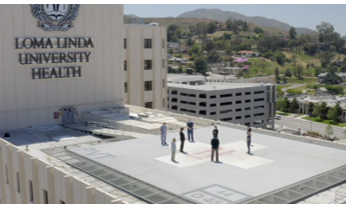 This month we were made aware of a prayer ceremony held on the helipad on top of the hospital. Watch this video to get a sense of what Bob is talking about.
This month we were made aware of a prayer ceremony held on the helipad on top of the hospital. Watch this video to get a sense of what Bob is talking about.
The prayer was coordinated by Kathy McMillan, director of employee spiritual care at the Medical Center. “Loma Linda University Health is built on a foundation of prayer and trust in divine guidance,” she said. “During this time, many have felt a need to pray with renewed fervency, so we gathered a group of employees from the hospital to represent our organization. It was truly a blessed time of prayer for our employees, administration, and our patients.”
LLUH is an institution that Bob, Pauline, and Deb enthusiastically support with personal contributions each year along with gifts built into their estate plans.
We hope that our members will consider doing something similar for this wonderful and deserving institution.
Give to the LLUH COVID-19 Relief Fund
While Loma Linda University Health is doing all they can to address their community’s healthcare needs during the coronavirus pandemic, they need help. The federal aid hospitals are receiving isn’t enough to meet the needs of their patients, students, and staff.
- Learn more about LLUH’s COVID-19 relief fund.
- Donate online.
- Call 909-558-5010.

Can Your Dog Get Prostate Cancer?
A staggering 50 percent of dogs over the age of 10 develop cancer at some point. The most common cancers are osteosarcoma (bone), mast cell (skin), lymphoma (lymph nodes), and hemangiosarcoma (cells that line blood vessels). Dogs are believed to be the only animal – besides humans – that can develop prostate cancer.
Although canine prostate cancer is uncommon, it’s typically aggressive and often fatal when it shows up. It usually goes undetected until the dog reaches an advanced stage. It can then spread quickly to the lymph nodes, bones, and lungs. Canine prostate cancer seems to develop without any known cause and can affect any breed of dog. It affects both neutered and intact male dogs, but usually occurs in older canines.
Cancer research for dogs (e.g. clinical trials) can offer canine patients the possibility of life extension or remission and it can be done at low cost. Once completed, the findings are used to help inform human clinical trials.
Useless Facts
- There are 158 verses in the Greek national anthem which makes it the longest national anthem in the world.
- It is impossible to tickle yourself.
- A typical pencil can draw a line that is 35 miles long.
- Astronauts get taller in space due to the lack of gravity.
- The total surface area of human lungs is 750 square feet. That’s roughly the same area as one side of a tennis court.
- Mosquitos have contributed to more deaths than any animal on earth.
- The hair on a polar bear isn’t actually white – it’s clear. It appears white because it reflects light.
- Buttermilk does not contain any butter and is actually low in fat.
- A giraffe can go longer without water than a camel.

Last Month’s Brain Teaser
A pregnant woman named her children: Dominique, Regis, Michelle, Fawn, Sophie, and Lara. What will she name her next child? This one is tough, but solvable …
Jessica, Katie, Abby or Tina?
Answer: Tina. She seems to follow the scale Do, Re, Me, Fa, So La, and then Ti.
Winner: Last month’s brain teaser winner from Cincinnati, OH wishes to remain anonymous. He told us, “After I read the second edition of Bob’s book, I plan to donate it to my local library.” We think that’s a great idea.
New Brain Teaser
How can you take 2 from 5 and leave 4?
Send your answer to [email protected] for a chance to win a signed copy of Bob Marckini’s NEW second edition book, You Can Beat Prostate Cancer.
Proper Perspective
Never laugh at your wife’s choices . . . you’re one of them.
Getting Smart
If your eye hurts after sipping your tea, take the spoon out of the cup.
Cockroach
Yesterday my husband saw a cockroach in the kitchen. He sprayed everything down and thoroughly cleaned the kitchen. Today I’m putting the cockroach in the bathroom.
Getting Old
One way to find out if you are old is to fall-down in front of a lot of people. If they laugh, you’re still young. If they panic and start running to you – you’re old.
COVID-19 is Nothing to Laugh About …
… But even in a pandemic, you can find some humor. (Source)
- Can we uninstall 2020 and reinstall it again? I think it has a virus.
- I just asked a 6-year-old if he understands why there’s no school. He said “Yes, because they’re out of toilet paper.”
- After years of wanting to thoroughly clean my house but lacking the time, this week I discovered that wasn’t the reason.
- If you thought toilet paper was crazy, just wait until 300 million people all want a haircut appointment.
- 2020 is a unique Leap Year. It has 29 days in February, 300 days in March and 5 years in April.
- Does anyone know if we can take showers yet or should we just keep washing our hands?
- My mom always told me I wouldn’t accomplish anything by lying in bed all day, but look at me now, I’m saving the world!
- I miss the days when we were terrified of romaine lettuce. Ahh, the good ol’ days …
- Whoever owes you money, go to their house now. They should be home.

Quote of the Month: "I am not what has happened to me. I am what I choose to become." —Carl Gustav Jung


Attitude is Everything
Four days before his 25th birthday, U.S. Army Staff Sgt. Travis Mills of the 82nd Airborne was caught in an IED (improvised explosive device) blast during his third tour of duty in Afghanistan. Against all odds, he lived, but he lost portions of both legs and arms.
In an instant, Travis’ life was drastically changed. He would never again be able to lead his squad, hold his wife’s hand, or pick up his 6-month-old daughter.
Travis’ rehabilitation was difficult – excruciating at times – but he struggled through the pain so he could regain the strength to live his life to the fullest. With tremendous willpower, the love of his family and friends, a generous amount of faith and an insatiable will to live and live well, Travis astounded everyone and recovered. Even without limbs, he swims, dances with his wife, rides mountain bikes, and drives his daughter to school.
Travis is a recalibrated warrior, motivational speaker, actor, author, and an advocate for veterans and amputees. He also has a New York Times bestselling memoir, Tough as They Come. Travis lives by his motto:
“Never give up. Never quit.”
A year and a half after his tragic accident, Travis and his wife Kelsey founded the Travis Mills Foundation, a nonprofit organization that benefits and assists 9/11 veterans who’ve been injured in active duty or as a result of their service to our country.
In a keynote speech for the National Committee for Quality Assurance, Travis begins, “I just hope I don’t bomb this, because last time look what happened...” Watch Travis as he tells his story with incredible humor, sincerity, and spirit.
Stay safe. Stay healthy. And low PSAs to all,
Bob Marckini and Deb Hickey
To print the BOB Tales newsletter or view the newsletter with a larger font size, click here for the PDF file.
NO MEDICAL ADVICE: Material appearing here represents opinions offered by non-medically-trained laypersons. Comments shown here should NEVER be interpreted as specific medical advice and must be used only as background information when consulting with a qualified medical professional.
